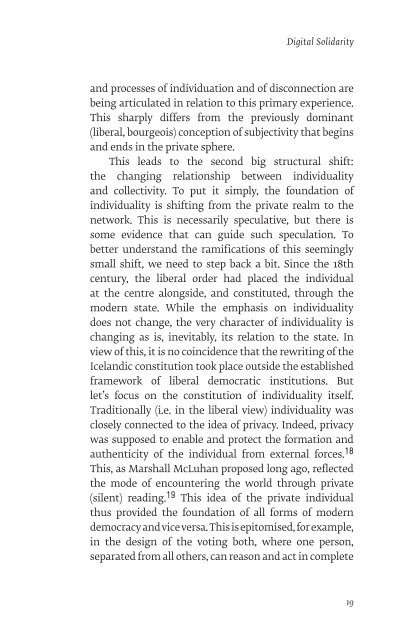KTub8
KTub8
KTub8
Create successful ePaper yourself
Turn your PDF publications into a flip-book with our unique Google optimized e-Paper software.
Digital Solidarity<br />
and processes of individuation and of disconnection are<br />
being articulated in relation to this primary experience.<br />
This sharply differs from the previously dominant<br />
(liberal, bourgeois) conception of subjectivity that begins<br />
and ends in the private sphere.<br />
This leads to the second big structural shift:<br />
the changing relationship between individuality<br />
and collectivity. To put it simply, the foundation of<br />
individuality is shifting from the private realm to the<br />
network. This is necessarily speculative, but there is<br />
some evidence that can guide such speculation. To<br />
better understand the ramifications of this seemingly<br />
small shift, we need to step back a bit. Since the 18th<br />
century, the liberal order had placed the individual<br />
at the centre alongside, and constituted, through the<br />
modern state. While the emphasis on individuality<br />
does not change, the very character of individuality is<br />
changing as is, inevitably, its relation to the state. In<br />
view of this, it is no coincidence that the rewriting of the<br />
Icelandic constitution took place outside the established<br />
framework of liberal democratic institutions. But<br />
let’s focus on the constitution of individuality itself.<br />
Traditionally (i.e. in the liberal view) individuality was<br />
closely connected to the idea of privacy. Indeed, privacy<br />
was supposed to enable and protect the formation and<br />
authenticity of the individual from external forces. 18<br />
This, as Marshall McLuhan proposed long ago, reflected<br />
the mode of encountering the world through private<br />
(silent) reading. 19 This idea of the private individual<br />
thus provided the foundation of all forms of modern<br />
democracy and vice versa. This is epitomised, for example,<br />
in the design of the voting both, where one person,<br />
separated from all others, can reason and act in complete<br />
19


